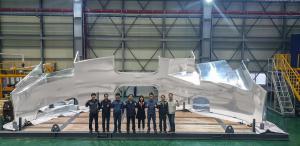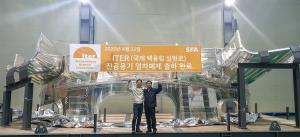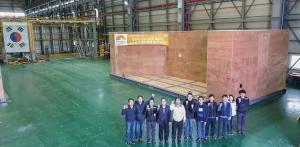Manufacturing
Thermal shield milestone in Korea
11 May 2020
Six years after the start of fabrication, Korean contractor SFA has completed the last 40° sector of vacuum vessel thermal shield. The stainless steel panels, covered with a 5- to 10-micrometre-thick layer of silver, are packed and ready for shipment.
The 12-metre-tall thermal shield component for vacuum vessel sector #2 has passed all factory acceptance tests.
Between the vacuum vessel and the magnets, the vacuum vessel thermal shield will block thermal loads from being transferred from warm components to the superconducting coils and structures that operate at 4.5K. Assembled from many joined panels, with piping for the active circulation of cooling gas (helium gas at 80-100 K), each 40° thermal shield sector will fit one vacuum vessel sector like a glove. A second layer of thermal shield (the cryostat thermal shield) will be installed between the magnets and the cryostat.
Korean contractor SFA has manufactured the thermal shield panels for all nine vacuum vessel sectors. In this view of sector #2 panels, cooling tubes are visible on the component's silver-coated surface.
Both layers must be made "opaque" to thermal radiation. This is achieved by coating all thermal shield surfaces with a material that radiates as little heat is as possible—silver.
After plate cutting, bending and forming, welding, final machining, and pre-assembly of the thermal shield, contractors placed the components in a silver bath where, by way of electroplating, a 5- to 10-micrometre-thick layer is deposited. The mass of silver coating on the thermal shield panels is estimated at just under 800 kg total (for a total surface of nearly 2,000 m²).
The panels of thermal shielding for vacuum vessel sector #2 were the last to be completed. After successful factory acceptance tests, they have been packed for shipment.




